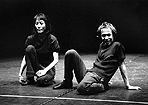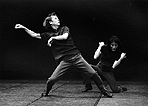
|
|
Apr. 8, 1997 (a)
|
Column Index - Mar. 25, 1997
![]()

"Dance Selection '96"
Kasai-Kisanuki Company
Kuniko Kisanuki
Butoh Dance| HIJIKATA, Tatsumi
Butoh Dance| OHNO, Kazuo
|
Is Dance-like Communication Possible?
"Dance Selection 96", planned and produced by An-Creative was held at the Spiral Hall. Entitled, "Special Duo Selection", three interesting combinations of duos danced over the two days of February 25th and 26th. The last of the performers was "Kasai-Kisanuki Company", or a new duo consisting of Akira KASAI and Kuniko KISANUKI. Akira KASAI is a dancer whose name is listed among the top performers that include Tatsumi HIJIKATA and Kazuo OHNO. KASAI has become a sort of legendary figure for not performing on stage in Japan for 14 years since moving to Germany in 1979. His performance in Japan, in 1994, was a shocking surprise that still remains fresh in our memory. Kuniko KISANUKI, on the other hand, is on the verge of creating her own "style", which is very rare in a world of contemporary dance in Japan that continues to undergo trials and errors. Expectations mounted for the collaboration between these two, and their performance successfully met, if not exceeded, the expectations. The Sisyphus of dance The dance started abruptly without the usual blackout before the stage performance. There was KASAI, hitting his body against different places, raising a queer voice, and there was KISANUKI, quietly showing a graceful yet sharp-moving dance. There, one could feel a premonition towards an unprecedented relationship between the dancers. KASAI made everything into substance or object -- the surrounding walls, the floor, devices or even his own body, voice, and thinking. By completely objectifying these things, he encountered "real things" (in a Lacan-like meaning), and he invested everything in the impossible identification. The dance, which was literally a battle with those "real things", is on the exact opposite of the dance of today that is confined to a hyper-real "style". Kasai took a risk in the "real thing" existing inside the other, writhing and dancing inside the impossibility of identification. Fatigue attempted to take KASAI away to a "normal" communication code (meaning, humor, provocation), but KASAI courageously resisted the temptation, entering the "battle" again. The Sisyphus of dance. The two "impossible" dances Meanwhile, KISANUKI, as if KASAI's existential battle did not exist, monotonously continued her own dance within indifference/uninvolvement. Like an egg in flux, the dance produced movement after movement, attempting to be self-sufficient. However, the more the dance attempted to be self-sufficient, and the more it strived to be indifferenct, the more it generated KASAI's dance. Here, probably, totally opposite dance-like communications crossed swords. The impossibility of Kasai dancing the "relationship" (with the other), and the impossibility of dancing the "uninvolvement" by KISANUKI, while becoming involved in a circling vortex, made one kind of dance possible. The audience were enthralled by the rare moment of dance that took place before them.
[Takaaki KUMAKURA/
|
|
|
|
|
|
|
|
|
Apr. 8, 1997 (a)
|
[home]/[Art information]/[Art Watch]
Copyright (c) Dai Nippon Printing Co., Ltd. 1997
Network Museum & Magazine Project / nmp@nt.cio.dnp.co.jp



